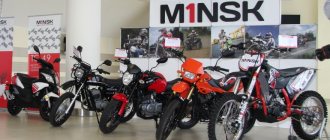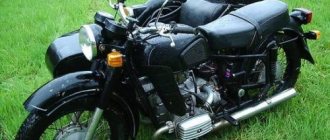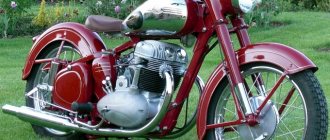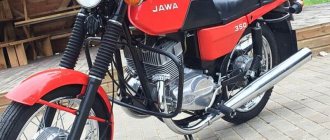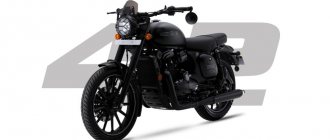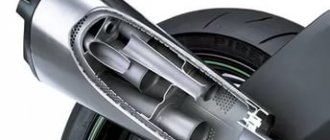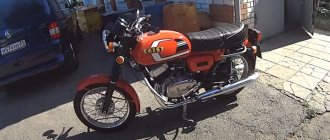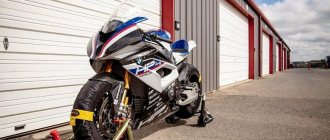Rate this post
In the post-war period, Europe needed simple and cheap transport. Small cars appeared there, but in the USSR the production of motorcycle equipment was actively developing. The motorcycle industry in the Union was well developed even before the war: since 1928, production of quite interesting IZH models was carried out, the large models IZH-1 and IZH-2, advanced at that time, with V-shaped “twos” for 1,200 cc The peculiarity of Soviet motorcyclists is that in the villages they mainly used motorcycles, which they often rode until something fell off.
That is, the main emphasis was placed on not servicing the motorcycle as much as possible, literally at all. In the city, on the contrary, they preferred imported motorcycles. As you know, such equipment is more demanding, requires love and, of course, regular maintenance. Among the main proposals, we should note the MZ produced by the GDR, Pannonia from Hungary and the Czech Jawa. The last motorcycle will be discussed further. We'll tell you why they bought Java and why it was remarkable.
Why did they buy it?
This motorcycle is known for its speed performance: “Java” was bought by those who could not live without the feeling when adrenaline is pumped into the blood, a feeling of euphoria arises. The motorcycle gave an incredible riding experience. Moreover, when a Jawa drove past the owners of Jupiter, Voskhod or IZh, it did not go unnoticed. This technique was known to everyone for its good performance characteristics; moreover, the elegant design of the motorcycle and the pleasant sound of the engine attracted attention. As for the model range, immediately after the end of the war the Jawa 250 appeared, and three years later the Jawa 350. These models sold like hotcakes in the USSR. The high cost did not scare away motorists either - 650 rubles was a lot of money for that time. But everyone understood perfectly well why they were giving such money, and had an idea of what they would receive in return. This brand symbolized reliability, prestige and high status.
The model range includes the following positions - Jawa 50, 125, 350, 650 and so on. Here you can find suitable motorcycle equipment for both beginner speed enthusiasts and experienced motorcycle enthusiasts. Equipment such as the Jawa 650 Dakar/Sportard is equipped with a 650 cc engine. There is the Jawa 650 Style, a motorcycle that is balanced in its characteristics. It is designed specifically for comfortable travel over long distances. The decline of Jawa production came with the collapse of the Soviet Union. The company was left with outdated models, although there were patents for various technologies that Czech engineers came up with, but they were used by completely different companies. It was thanks to patents that Java continued to exist in the future, but never became a global manufacturer. They began to produce budget motorcycles that can compete in their segment, but the level of interest in new models is noticeably lower than before. The modern Java is built on its own chassis and equipped with foreign-made engines; the chassis, as before, is quite reliable.
New Jawa motorcycles
The iconic Jawa brand has introduced two new motorcycles for the 2017 model year: the classic Jawa 350 and the all-new 660 Vintage.
Today, few people know that the plant in the Czech Republic is still operating and continues to produce motorcycles that more than one generation of our compatriots have dreamed of. Moreover, the model range is almost identical to what was offered in the late eighties: 350 cc two-stroke motorcycles received only electronic ignition, an oil pump and a front disc brake.
Jawa 350 with updated fuel injection engine
The devices being produced no longer comply with the new European environmental requirements, so new models are, to a certain extent, a forced step.
The new Jawa 350 has actually become a modified copy of the Chinese Shineray XY400, which in turn is reminiscent of the Yamaha SR400 - the chassis is not “Java” at all, but the fuel tank with branded chrome-plated sides and the side trims of the new retro bike can knock a tear out of any retrograde.
Jawa 350 is a truly new motorcycle produced by the legendary Czech factory
The engine is four-stroke, single-cylinder, with a power of 27.7 horsepower, which, with a volume of 397 cm3, indicates a four-valve cylinder head. The maximum speed is 130 km/h, and most importantly, the emission standards comply with the Euro 4 standard, which means the motorcycle can again be sold on the European market. The new Jawa 350 can already be purchased in European countries at a price of $3,870. In Russia, by the way, “Jawas” are still sold to this day, so the chances of the new product getting to domestic dealers are quite good.
Photos of Jawa 350 2022:
Jawa 660 Vintage
The second premiere looks no less interesting, although its chances of ending up in Russia are much lower. The new Jawa 660 Vintage is built on the basis of the Jawa 660 Sportard motard, which did not gain popularity due to its high price and low quality. However, it is the single-cylinder 651 cc Minarelli engine that has proven itself on both the Yamaha XT and the Aprilia Pegaso, and the power of 49 horsepower is quite enough to feel confident in city traffic.
At the heart of the Jawa 650 Vintage is the time-tested “single-barrel” Minarelli
The motorcycle, whose appearance combines notes of nostalgia and neoclassics, like the Sportrad, has a Paioli fork and a Bitubo rear shock absorber, as well as a 19-inch front wheel.
The dry weight of the Jawa 660 Vintage is 198 kg.
The Jawa 660 Vintage will have to compete with such monsters as the Moto Guzzi V6, Ducati Scrambler and Triumph Bonevile, and the stated price of the new item at $7,000 can play an important role in this fight.
Video of the new Jawa 350 2022:
You may be interested in: Review and test drive of the new Jawa 350 Lux from Dmitry Fedotov (with video!)
Subscribe to Omoimot magazine updates on VKontakte, Facebook, Twitter or Google+ to learn about the most interesting new products in the motorcycle industry in detail.
Photos – auto.cz
Small-scale production of motorcycles was established in Czechoslovakia back in the first decade of the last century, but a new page in the history of motorcycle technology began in 1929, when the owner of the arms factory, Frantisek Janecek, converted it to produce motorcycles. Janecek purchased a license for a 500 cc rear-wheel drive model from the German company Wanderer and released the first basic model of the motorcycle under the Jawa brand. The name of the brand is deciphered quite simply, since these are the first letters of the names of its creators: “Ja” - from Janechek and “Wa” - from Wanderer.The first Jawa motorcycle was not only heavy but also expensive, which is why it didn't excite consumers much. It was necessary to save the situation, and Janecek invited the English designer George William Patchett to develop a new model. Janecek's expectations were justified: in 1932, the lightweight Jawa 175cc Villiers motorcycle was introduced, which quickly gained popularity. Inspired by the success, Janecek began producing 250 cc and 350 cc motorcycles with a four-stroke engine for lovers of powerful motorcycles. In 1937, the debut of one of the most popular models at that time took place - the 100 cc Jawa-Robot motorcycle.
By the end of the 30s, the Jawa motorcycle plant began to play a very significant role in the motorcycle industry of Czechoslovakia, but at the same time another weapons factory, CZ, began producing motorcycles, which began producing 100-, 125- and 350-cc motorcycles with a two-stroke engine. Throughout the war, until 1945, the CZ and Jawa factories were engaged in the manufacture of weapons and repair of equipment for the front. The Jawa motorcycle factory, however, did not give up hope of returning to its main product and even managed to secretly design and test a series of motorcycles, as a result of which the Jawa 250/350 Perak was presented at the Paris Motor Show in 1946. The motorcycle created a sensation as it was an innovative model with a new frame design, hydraulic shock absorbers and a gearbox coupled with automatic clutch release. Two years later, the Jawa-350 with a two-cylinder engine and the Jawa racing motorcycle with a 498 cc engine appeared.
The “golden time” of the Jawa motorcycle plant was in the 50s and 60s, when Jawa models began to be exported to the Soviet Union, which became their main consumer. These were Java-250 and Java-350, well known to Soviet motorsports enthusiasts. The plant became more active in producing racing motorcycles, since thanks to these models the Czechoslovakian team repeatedly won international competitions. The 60s were marked by big changes for the Jawa motorcycle plant, since by government decision the head plant of the Jawa association in Prague was reoriented to the production of semiconductor industry products. For the production of Jawa motorcycles, another enterprise was allocated, which, together with the CZ plant, began to produce unified models. At that time, mainly sports motorcycles were produced for motocross and road racing, and the apotheosis was the Java model released in the late 60s with a four-cylinder liquid-cooled engine.
In the 70s, Jawa motorcycles continued to be actively exported to the Soviet Union and the Eastern Bloc countries. In 1973, mass production of the Jawa-350/634 model began, a road motorcycle with a modernized engine and a new tubular frame. The plant remained true to its sports traditions and in those years produced Jawa sports motorcycles for speedway and multi-day competitions, in which the Czechoslovak team repeatedly became the winner. The beginning of the 80s became the most difficult period for the Jawa motorcycle factory: a new type of classic motorcycle took shape in the West - a model with a four-stroke engine and a piston instead of a disc valve, and Czechoslovak motorcycles turned out to be far from this “ideal”. After the collapse of the USSR, Jawa motorcycles ceased to be in demand in their main market, as a result of which the Jawa parent plant found itself in a critical situation. In subsequent years, attempts were made to modernize the models being produced, but it was not possible to return the former demand for Jawa motorcycles.
Despite this, the Jawa motorcycle factory continued its activities, and in 1987 the 3 millionth motorcycle of this famous brand was produced. In 1997, a new company, Jawa Moto, was formed, which over the past decade has released several models: in particular, Jawa-650 Classic, Jawa-650 Style and Jawa-650 Dakar. The successor to the famous manufacturer of Czechoslovak motorcycles, Jawa Moto, has not forgotten the role that exports to the USSR played in the history of the Czechoslovak motorcycle industry. The company has already announced its intention to resume supplies of Java motorcycles to the markets of the countries of the former Union and intensify their sales. And “Java” will definitely succeed, since there is no need to introduce Java motorcycles to Russian motorcycle enthusiasts.
Excursion into history
When Java was popular there was no Internet, so the history of the motorcycle was unknown to few people. People were satisfied that the bike looked cool, was fast and reliable. And everything else was not important then. However, some believed that Java's popularity was due to the fact that it simply had no competitors at the time.
This is an erroneous opinion, since at the same time the motorcycle took part in various sports competitions. He showed himself best on speed tracks. Java was ridden by such successful riders of the time as Bari Briggs from New Zealand and Oli Olsen from Denmark. Largely thanks to the Czech motorcycle, they were able to become world champions.
With the advent of Internet access, studying the history of the Czech brand has become very easy. The plant was founded in 1929. Jawa began supplying its products to the USSR after the end of the Second World War. Initially, 100 thousand motorcycles per year came to our country. In 1964, a significant event occurred: the millionth Java came off the assembly line. Further, the rate of production increased, and already in 1976 the total circulation amounted to 2 million.
The most popular motorcycle of the Czech plant was considered the Java 638, released in 1984. After this, production of its modifications began. Two years later, a new model 350-638-00 appeared. After this, the modernization of the “classics” continued and in 1990 the Java 350-638 rolled off the assembly line.
